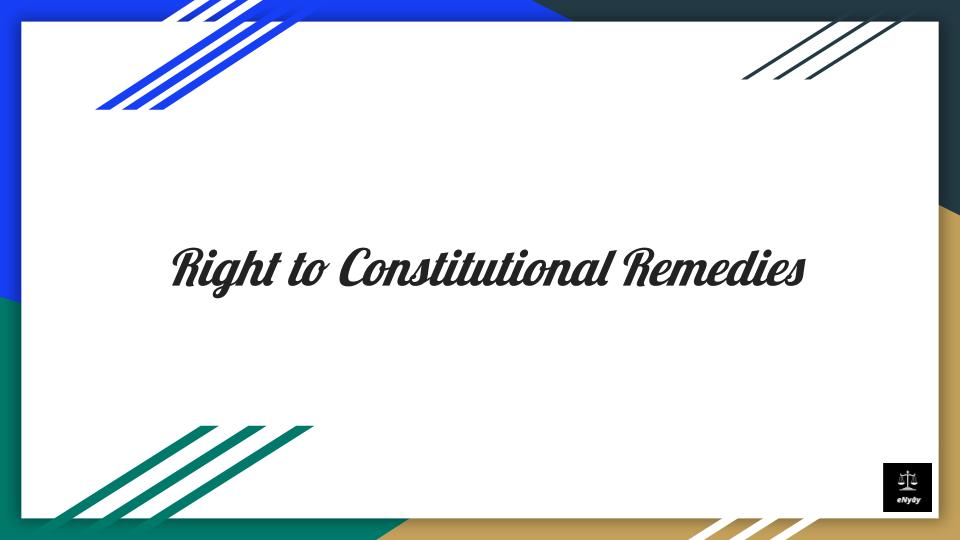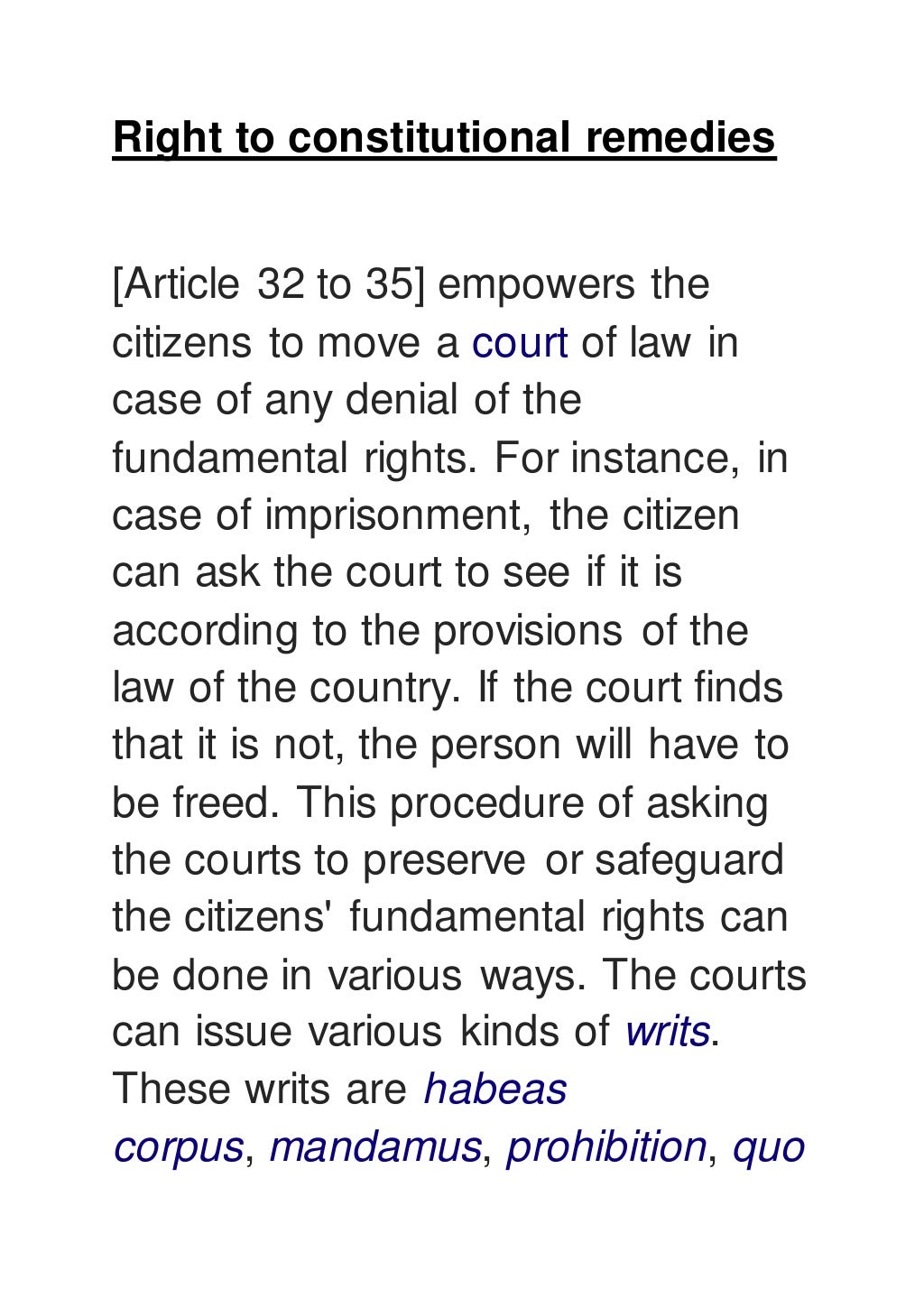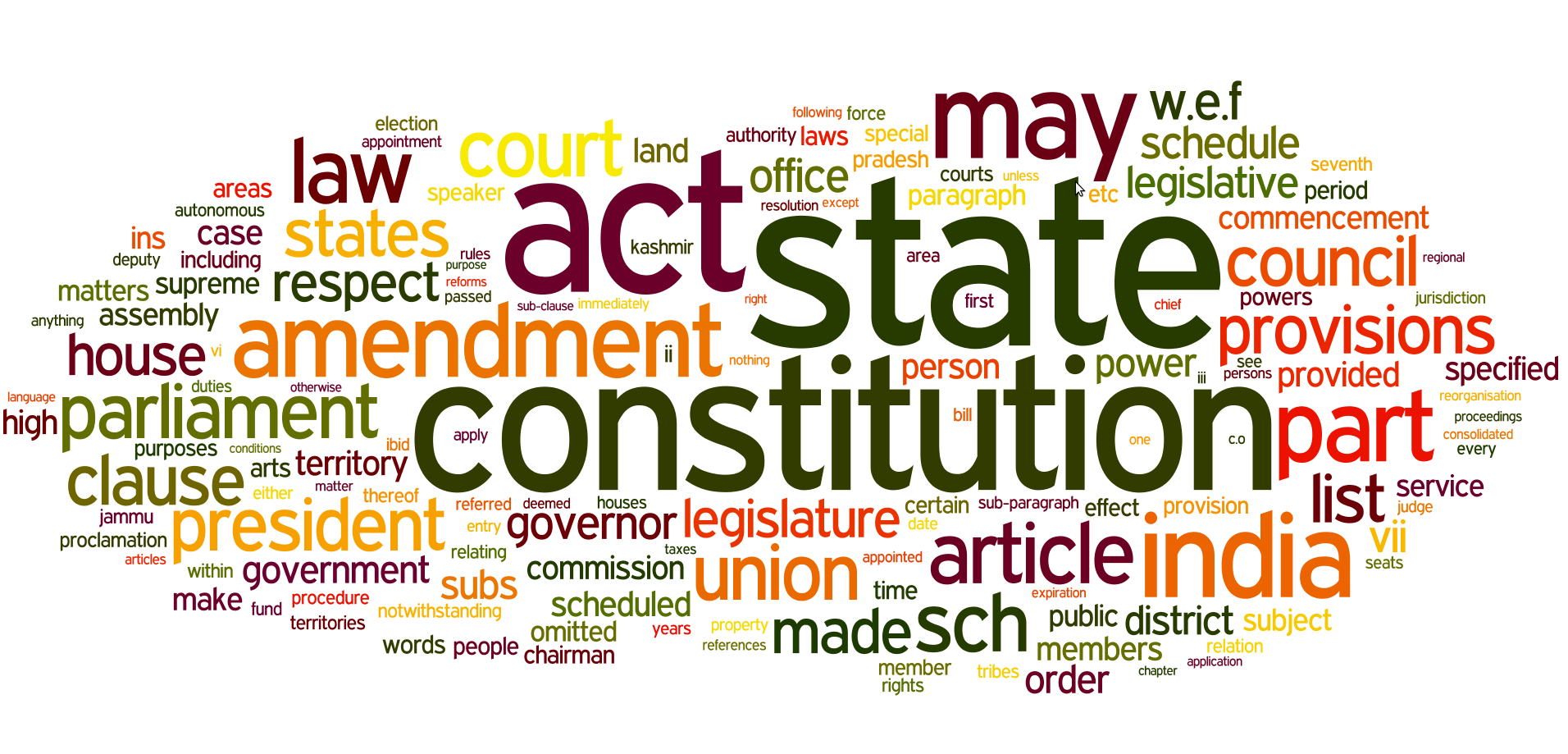
Article 32 Right to Constitutional Remedies YouTube
^See Walter E. Dellinger, Of Rights and Remedies: The Constitution as a Sword, 85 Harv. L. Rev. 1532, 1552-53 (1972) ("Congress may legislate an alternative remedial scheme which it considers equally effective in enforcing the Constitution and which the Court, in the process of judicial review, deems an adequate substitute for the displaced.

Right to constitution Remedies Legal Vidhiya
There are five kinds of constitutional remedies available. 1 These are: Habeas Corpus. The term 'habeas corpus' literally means 'produce the body'. In this context, it refers to a direction from a court to bring a person before the court. If a person is illegally restrained and deprived of their liberty, a writ petition for habeas.

Constitutional Remedies का अधिकार LawSikho Hindi YouTube
Right to constitutional remedies. Article 32 is known as the "spirit of the constitution and exceptionally heart of it" by Dr. Ambedkar. Preeminent Court has included it in fundamental structure regulation. Further, it is clarified that privilege to move to Supreme Court can't be suspended with the exception of generally given by the.

Right to Constitutional Remedies Article 32 UPSC Polity Notes
The term "right to constitutional remedies" typically refers to a fundamental right granted to citizens in India. It is a crucial element of constitutional law and provides individuals with the means to seek legal redress when their fundamental rights are violated by the government or any other entity.

Right to Constitutional Remedies enyay.in
Rights, Structure, and Remediation. abstract. In The Collapse of Constitutional Remedies, Aziz Huq challenges the idealistic view of federal courts as faithful exponents of the Constitution's protections for liberty. He insists that the Framers' design of Article III is fundamentally flawed, resulting in a judiciary that is ill-disposed to.
Right To Constitutional Remedies Means
constitutional right will be cheapened. INTRODUCTION t is a settled and invariable principle," Chief Justice Marshall once wrote, "that every right, when withheld, must have a remedy."1 Not quite. Although some view the idea of a substantive constitutional right without a remedy as oxymoronic,2 rights to remedies have always

Article 32 of Indian Constitution [Right To Constitutional Remedies] Legal 60
Constitutional Remedies: In One Era and Out the Other. Vol. 136 No. 5 March 2023 "It is a settled and invariable principle," Chief Justice Marshall once wrote, "that every right, when withheld, must have a remedy.". Not quite. Although some view the idea of a substantive constitutional right without a remedy as oxymoronic, rights to.

Article 32 of Indian Constitution Right of Constitutional Remedy civilservice uppcs bpsc
Abstract Despite the ringing dictum of Marbury v. Madison that "every right, when withheld, must have a remedy," rights to remedies have always had a precarious constitutional status. For over one hundred years, the norm was that victims of ongoing constitutional violations had rights to injunctive relief.

digikul Digikul
Right to Constitutional Remedies Part III of the Constitution provides for legal remedies for the protection of these rights against their violation by the State or other institutions/individuals. It entitles the citizens of India to move the Supreme Court or High Courts for the enforcement of these rights.

Law Day Drawing Constitution Day of India Drawing National Law Day Poster Drawing Very Easy
Find the deal you deserve on eBay. Discover discounts from sellers across the globe. No matter what you love, you'll find it here. Search Constitutional right and more.

Right To Constitutional Remedies (Article 32)
Updated on: November 14th, 2023. The right to Constitutional Remedies is the right provided to the citizens of India to move to either the High Court or Supreme Court to protect their fundamental rights. Article 32 of the Indian Constitution defines the Right to constitutional remedies of the Supreme Court and Article 226 of the High Court.

Right to constitutional Remedies( writs) CGPSC Exam Notes
Right to constitutional remedies is the way through which this can be achieved. Dr Ambedkar considered the Right to Constitutional Remedies as the 'heart and soul of the constitution. This is so because it entitles the citizens of our country to move to the Supreme Court of High Court for enforcement of these rights and along with that the.

Right to constitutional remedies and judicial review
interpretations of a statutory text . . . ."). But since avoidance does the same work as constitutional remedies, namely solving a statutory violation of the Constitution, it is included in this Article's theory of constitutional remedy selection. For ease of writing and reading, the avoidance canon is referred to as a remedy throughout.

ARTICLE 32(RIGHT TO CONSTITUTIONAL REMEDIES)(PART 7)FUNDAMENTAL RIGHTSINDIAN POLITY YouTube
constitutional right to a remedy and the close link between the First Amendment's Petition Clause and remedy-guaranteeing provisions in state constitutions. See Phillips, supra note 3, at 1310 (describing "the guarantee of a right of access to the courts to obtain a remedy for injury" as the "most widespread and important of . . .

Right to Constitutional Remedies Lesson 1 YouTube
This article examines the history and significance of the constitutional right to a remedy, which is often overlooked or underenforced by courts. The author argues that the right to a remedy is essential for preserving the rule of law, protecting individual rights, and ensuring democratic accountability. The article also explores the challenges and opportunities for vindicating the right to a.

Finding Constitutional Texts Comparative Constitutional Law Research Guide Research Guides
Thomas R. Phillips. Of all the rights guaranteed by state constitutions but absent from the federal Bill of Rights, the right to a remedy through open access to the courts may be the most important. The remedy clause, which appears in the constitutions of forty states, usually takes one of two basic forms, but courts have interpreted and.